Secularization, Religious Denominations, and Differences in Regional Characteristics: The State of Research and a Regional Statistical Investigation for Germany
Abstract
1. Introduction
1.1. Spatial Distributions and Development of Secularization and Religious Denominations in Germany
1.2. State of Research
1.2.1. Demographic Factors
Be fruitful and increase in number; fill the earth, and subdue it. Rule over the fish in the sea and the birds in the sky and over every living creature that moves on the ground.(Genesis 1: 28)
1.2.2. Economic Factors
On the seventh day God rested. And God saw everything that he had made, and, behold, it was very good.(Constantine I: Dies Solis 321 A.D.)
2. Material and Methods
3. Results
3.1. Pattern of Spatial Distribution
3.2. Correlations and Partial Correlations between Denominational Affiliation and Socio-Economic Characteristics
3.2.1. Hypotheses
3.2.2. Results
4. Discussion
5. Conclusions and Further Research
Author Contributions
Funding
Conflicts of Interest
References
- Alexander, Thomas G., and Jessie L. Embry. 1983. After 150 Years: The Latter Day Saints in Sequientennial Perspective. Salt Lake City: Signature Books. [Google Scholar]
- Asche, Christian. 2014. Glaube als Fortschrittskiller: Wie Religion die Wirtschaft ausbremst. Huffington Post. Available online: http://www.huffingtonpost.de/2014/09/05/religion-wirtschaft_n_5771400.html (accessed on 12 March 2018).
- Bähr, Jürgen. 1992. Bevölkerungsgeographie: Verteilung und Dynamik der Bevölkerung in Globaler, Nationaler und Regionaler Sicht. Stuttgart: Eugen Ulmer. [Google Scholar]
- Bénabou, Roland, Davide Ticchi, and Andrea Vindigni. 2014. Forbidden Fruits: The Political Economy of Science, Religion, and Growth. Huffington Post. Available online: http://www.huffingtonpost.de/2014/09/05/religion-wirtschaft_n_5771400.html (accessed on 12 March 2018).
- Bénabou, Roland, Davide Ticchi, and Andrea Vindigni. 2015. Forbidden Fruits: The Political Economy of Science, Religion, and Growth. Cambridge: National Bureau of Economic Research. [Google Scholar]
- Blume, Michael. 2014. Religion und Demografie. Warum es ohne Glauben an Kindern Mangelt. Filderstadt: Sciebooks Verlag. [Google Scholar]
- Blume, Michaela, Carsten Ramsel, and Sven Graupner. 2007. Religiosität als demographischer Faktor—Ein unterschätzter Zusammenhang? In Marburg Journal of Religion. vol. 11. [Google Scholar] [CrossRef]
- Büttner, Manfred. 1998. Der Arbeitskreis Geographie der Geisteshaltung und Religion/Umweltforschung: Tradition und Fortschritt. Festschrift zum 50jährigen Bestehen der Heidelberger Geographischen Gesellschaft. HGG-Journal 12: 166–69. [Google Scholar]
- Cantoni, Davide. 2015. The Economic Effects of the Protestant Reformation: Testing the Weber Hypothesis in the German Lands. Journal of the European Economic Association 13: 561–98. [Google Scholar] [CrossRef]
- Compton, Paul A., and John Coward. 1989. Fertility and Family Planning in Northern Ireland. Gower: Aldershot Hants. [Google Scholar]
- Copeland, Kenneth. 2007. Die Geistlichen Gesetze des Wohlstands. Runding: Shalom-Verlag. [Google Scholar]
- Danielzyk, Rainer, and Claus-Christian Wiegandt. 1985. Lingen im Emsland—Dynamisches Entwicklungszentrum oder “Provinz”?: Ansätze zu e. Qualitativen Methodik in der Regionalforschung. Paderborn: Schöningh. [Google Scholar]
- Danielzyk, Rainer, Rainer Krüger, and Benjamin Schäfer. 1995. Ostfriesland: Leben in Einer “Besonderen Welt”: Eine Untersuchung zum Verhältnis von Alltag, Kultur und Politik im Regionalen Massstab. Oldenburg: Bis. [Google Scholar]
- Eicken, Joachim, and Ansgar Schmitz-Veltin. 2010. Die Entwicklung der Kirchenmitglieder in Deutschland. Statistische Anmerkungen zu Umfang und Ursachen des Mitgliederrückgangs in den beiden christlichen Volkskirchen. Wirtschaft und Statistik 6: 576–89. [Google Scholar]
- Engelhard, Kerstin. 1995. Frauenförderung als Entwicklungspolitische Aufgabe. Eine Entwicklungspolitische Analyse am Beispiel der Rolle der Frau in Ausgewählten Wirtschaftszweigen Marokkos. Breitenbach: Verlag für Entwicklungspolitik. [Google Scholar]
- Eurich, Johannes, and Christofer Frey. 2008. Intergenerationalität zwischen Solidarität und Gerechtigkeit: Festgabe für Christofer Frey zum 70. Geburtstag. Heidelberg: Winter. [Google Scholar]
- Gorski, Philip S. 2000. Historicizing the Secularization Debate: Church, State, and Society in Late Medieval and Early Modern Europe, ca. 1300 to 1700. American Sociological Review 65: 138–67. [Google Scholar] [CrossRef]
- Grier, Robin. 1997. The Effect of Religion on Economic Development: A Cross National Study of 63 Former Colonies. Kyklos 50: 47–62. [Google Scholar] [CrossRef]
- Hagin, Kenneth E. 2013. Was Gott mich über Wohlstand lehrte. Augusburg: Durchbruch-Verlag. [Google Scholar]
- Heisig, Tobias. 2012. (K)eine Option für die Reichen? Leistungsmilieus als Theologischer Ort. Ostfildern: Matthias-Grünewald-Verlag. [Google Scholar]
- Henkel, Reinhard. 1998. Der Arbeitskreis Religionsgeographie. HGG-Journal 12: 269–72. [Google Scholar]
- Henkel, Reinhard. 2001. Atlas der Kirchen und der Anderen Religionsgemeinschaften in Deutschland: Eine Religionsgeographie. Stuttgart, Berlin and Köln: Kohlhammer. [Google Scholar]
- Henkel, Reinhard. 2004. Der Ort der Religionen. Beobachtungen zu neueren Entwicklungen in der Religionsgeographie. Berichte zur deutschen Landeskunde 78: 141–65. [Google Scholar]
- Höcker, Bertold, and Matthias Herzberg. 2014. Werte und Wohlstand: Das abendländisch-christliche Menschenbild als Erfolgsfaktor eines Unternehmens. Berlin: Palmedia. [Google Scholar]
- Hölscher, Lucian, ed. 2001. Datenatlas zur religiösen Geographie im protestantischen Deutschland: Von der Mitte des 19. Jahrhunderts bis zum Zweiten Weltkrieg. Berlin and New York: de Gruyter. [Google Scholar]
- Inglehart, Ronald, and Wayne E. Baker. 2000. Modernization, Cultural Change, and the Persistence of Traditional Values. American Sociological Review 65: 19–51. [Google Scholar] [CrossRef]
- INKAR. 2018. Indikatoren und Karten zur Raumentwicklung. Available online: www.inkar.de (accessed on 30 October 2018).
- Iyer, Sriya. 2016. The New Economics of Religion. Journal of Economic Literature 54: 395–441. [Google Scholar] [CrossRef]
- Karstein, Uta, and Monika Wohlrab-Sahr. 2016. Religiöser Wandel als Generationenwandel?–Betrachtungen zum Generationenkonzept am Beispiel ostdeutscher Generationenverhältnisse. In Der Osten. Edited by Matthäus Sandra and Daniel Kubiak. Wiesbaden: Springer, pp. 17–44. [Google Scholar]
- Kirchenaustritt. 2018. Mitgliederentwicklung in den Religionsgemeinschaften. Available online: https://www.kirchenaustritt.de/statistik/religionszugehorigkeit (accessed on 1 November 2018).
- Körner, Christoph. 2017. Christliche Sozialökonomie. Auf dem Weg zu Gerechtigkeit, Frieden und Bewahrung der Schöpfung. Zell a. Main: Verlag Religion & Kultur. [Google Scholar]
- Lehrer, Evelyn L. 2004. Religion as a Determinant of Economic and Demographic Behavior in the United States. Population & Development Review 30: 707–26. [Google Scholar] [CrossRef]
- Lewer, Joshua J., and Hendrik van den Berg. 2007. Religion and International Trade: Does the Sharing of a Religious Culture Facilitate the Formation of Trade Networks? American Journal of Economics & Sociology 66: 765–94. [Google Scholar] [CrossRef]
- Norris, Pippa, and Ronald Inglehart. 2004. Sacred and Secular: Religion and Politics Worldwide. Cambridge: Cambridge University Press. [Google Scholar]
- Peri-Rotem, Nitzan. 2016. Religion and Fertility in Western Europe: Trends Across Cohorts in Britain, France and the Netherlands. European Journal of Population = Revue europeenne de demographie 32: 231–65. [Google Scholar] [CrossRef] [PubMed]
- Posener, Alan. 2013. Ostdeutschland—Die ungläubigste Region der Welt. Die Welt. Available online: https://www.welt.de/politik/deutschland/article114889749/Ostdeutschland-die-ungläubigste-Region-der-Welt.html (accessed on 12 March 2018).
- Rinschede, Gisbert. 1999. Religionsgeographie. Braunschweig: Westermann. [Google Scholar]
- Sander, H. J. 1974. Estructura Social y Confesional en un Pueblo de Campesinos des Estado Federal Tlaxcala, México. Xalcatzingo, Municipio de Tepeyanco Communicationes 11: 77–83. [Google Scholar]
- Spenkuch, Jörg L. 2017. Religion and work: Micro evidence from contemporary Germany. Journal of Economic Behavior & Organization 135: 193–214. [Google Scholar] [CrossRef]
- Statistisches Bundesamt. 2020. Religionszugehörigkeiten. Available online: https://www.regionalstatistik.de/genesis//online/data?operation=table&code=12111-06-01-4&levelindex=0&levelid=1590741223365 (accessed on 29 May 2020).
- Strulik, Holger. 2016. Secularization and long-run economic growth. Economic Inquiry 54: 177–200. [Google Scholar] [CrossRef]
- Tamney, Joseph B., Shawn Powell, and Stephen Johnson. 1989. Innovation Theory and Religious Nones. Journal for the Scientific Study of Religion 28: 216–29. [Google Scholar] [CrossRef]
- Theile, Gustav. 2019. Das neue Jahrhundert der Religionen. FAZ. Available online: https://www.faz.net/aktuell/wirtschaft/schneller-schlau/das-neue-jahrhundert-der-religionen-16452789.html (accessed on 12 March 2018).
- Thieme, Günter. 1984. Disparitäten der Lebensbedingungen—Persistenz oder raum-zeitlicher Wandel? Untersuchungen am Beispiel Süddeutschlands 1895 und 1980 (Disparities of Living Conditions—Continuity or Spatio-Temporal Change? The Example of Southern Germany, 1895 and 1980). Erdkunde 38: 258–267. [Google Scholar]
- University Luzern. 2019. Swiss Metadatabase of Religious Affiliation in Europe. Available online: https://www.smre-data.ch/en/data_exploring/dataset_cockpit#/mode/view_dataset/dataset/1562 (accessed on 12 October 2019).
- van Poppel, Frans W. A. 1985. Late fertility decline in the Netherlands: The influence of religious denomination, socio-economic group and region. European Journal of Population = Revue Europeenne De Demographie 1: 347–73. [Google Scholar] [CrossRef]
- Vossen, Joachim. 2003. Religionsgeographie. Eine Disziplin wachsender gesellschaftlicher Relevanz. Praxis Geographie 33: 4–7. [Google Scholar]
- Weber, Max, and Dirk Käsler. 2013. Die Protestantische Ethik und der Geist des Kapitalismus. München: Beck. [Google Scholar]
- Weber, Max. 1904. Die protestantische Ethik und der ‘Geist’ des Kapitalismus. Archiv für Sozialwissenschaften und Sozialpolitik 20–21: 1–110. [Google Scholar]
- Wenzler, Simone. 2009. Familienpolitik heute: Was tut die Politik (nicht) für Familien!? In Familienpolitik: Biblisch-christliches Familienbild und kulturelle Globalisierung. In Marktwirtschaft und Ethik 13. Edited by Lachmann Werner, Reinhard Haupt and Karl Farmer. Berlin: Lit, pp. 1–36. [Google Scholar]
- Wilber, Charles K., and Kenneth P. Jameson. 1980. Religious values and social limits to development. World Development 8: 467–79. [Google Scholar] [CrossRef]
- Wohlrab-Sahr, Monika, Uta Karstein, and Thomas Schmidt-Lux. 2009. Forcierte Säkularität. Religiöser Wandel und Generationendynamik im Osten Deutschlands. Frankfurt am Main: Campus. [Google Scholar]
- Wunder, Edgar. 2004. Was geschieht in Deutschland mit der Religion? Berichte zur deutschen Landeskunde 78: 167–92. [Google Scholar]
- Wunder, Edgar. 2005. Religion in der Postkonfessionellen Gesellschaft. Ph.D. dissertation, University of Heidelberg, Stuttgart, Germany. [Google Scholar]
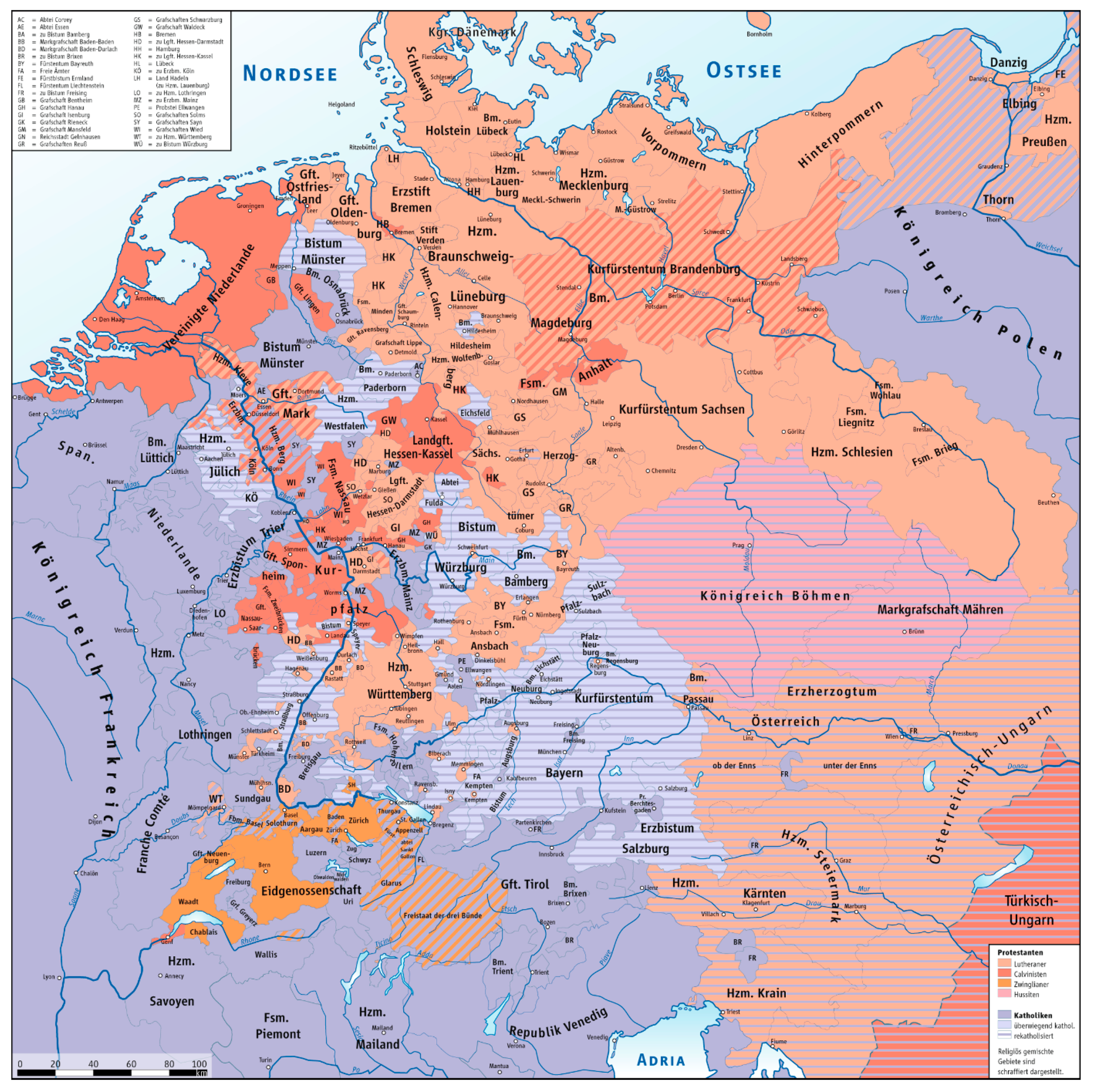

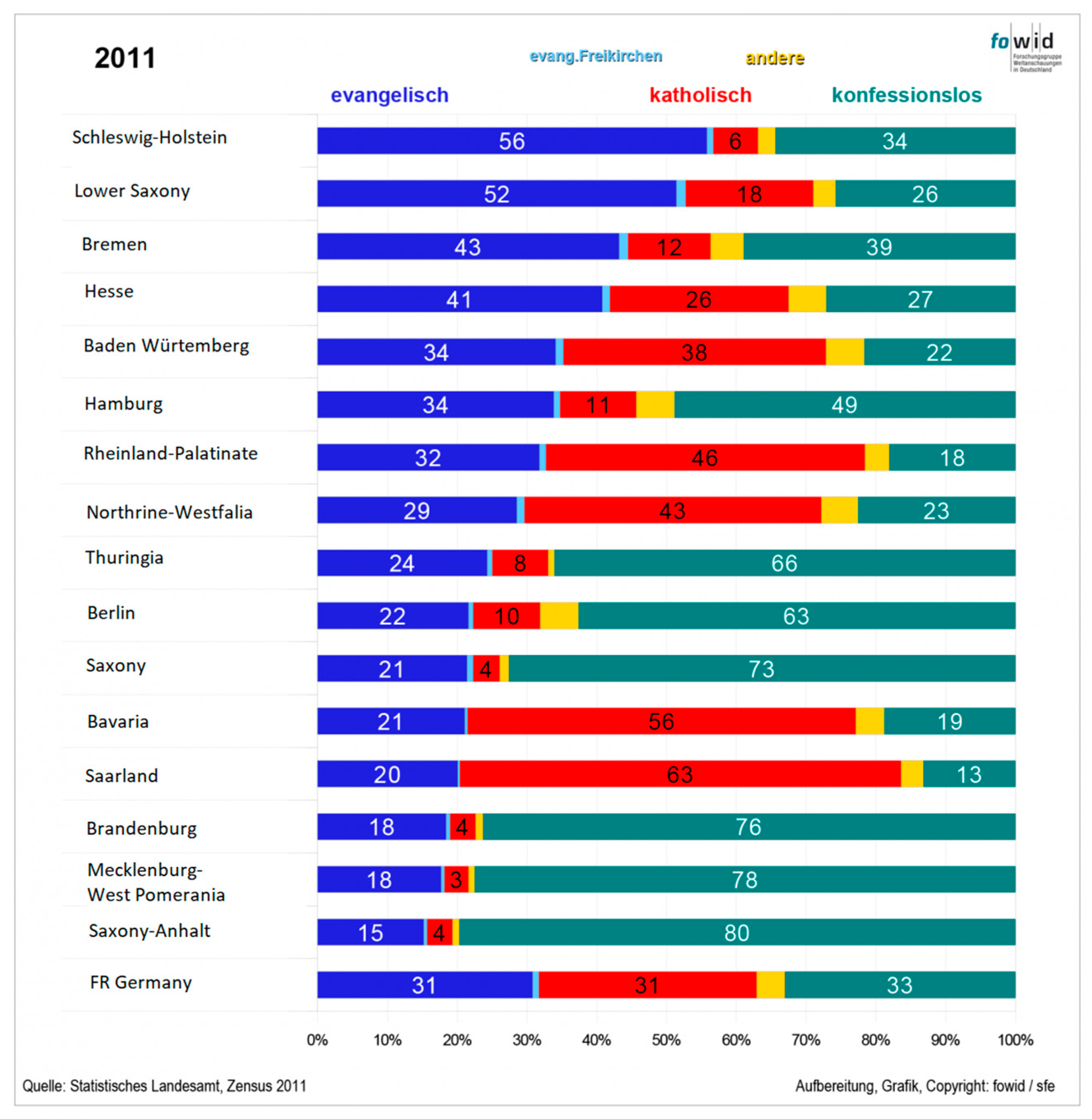
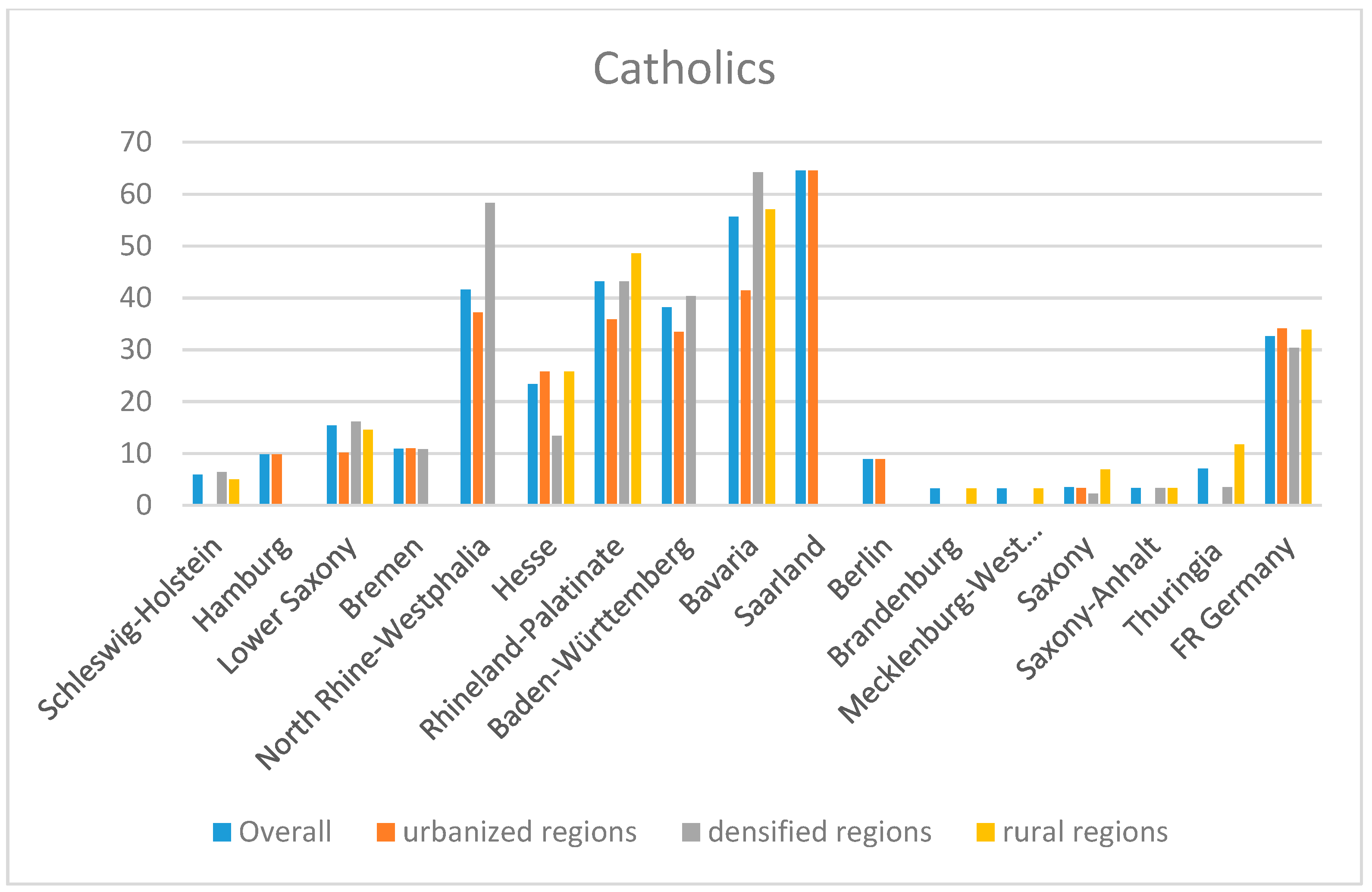
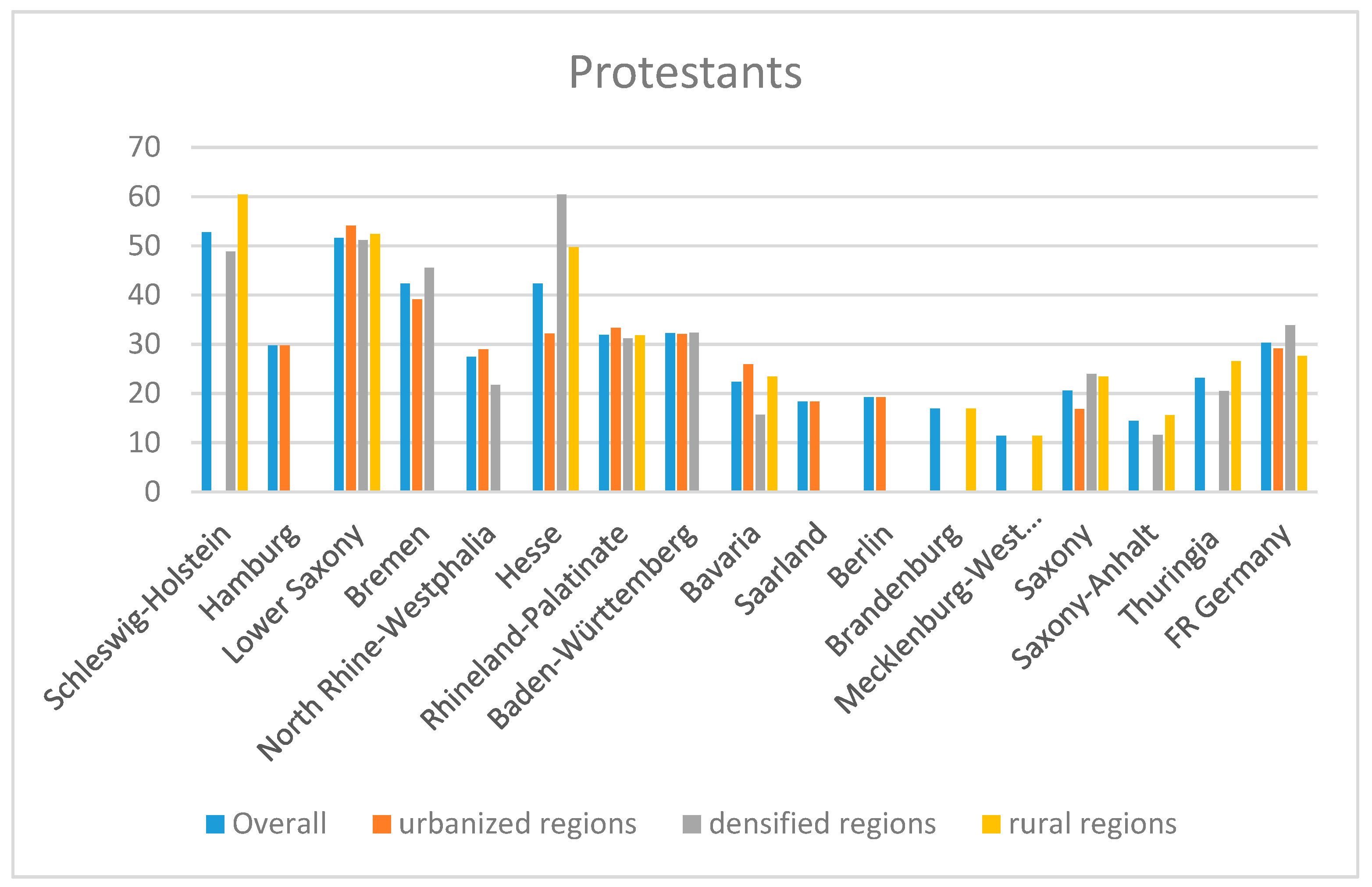
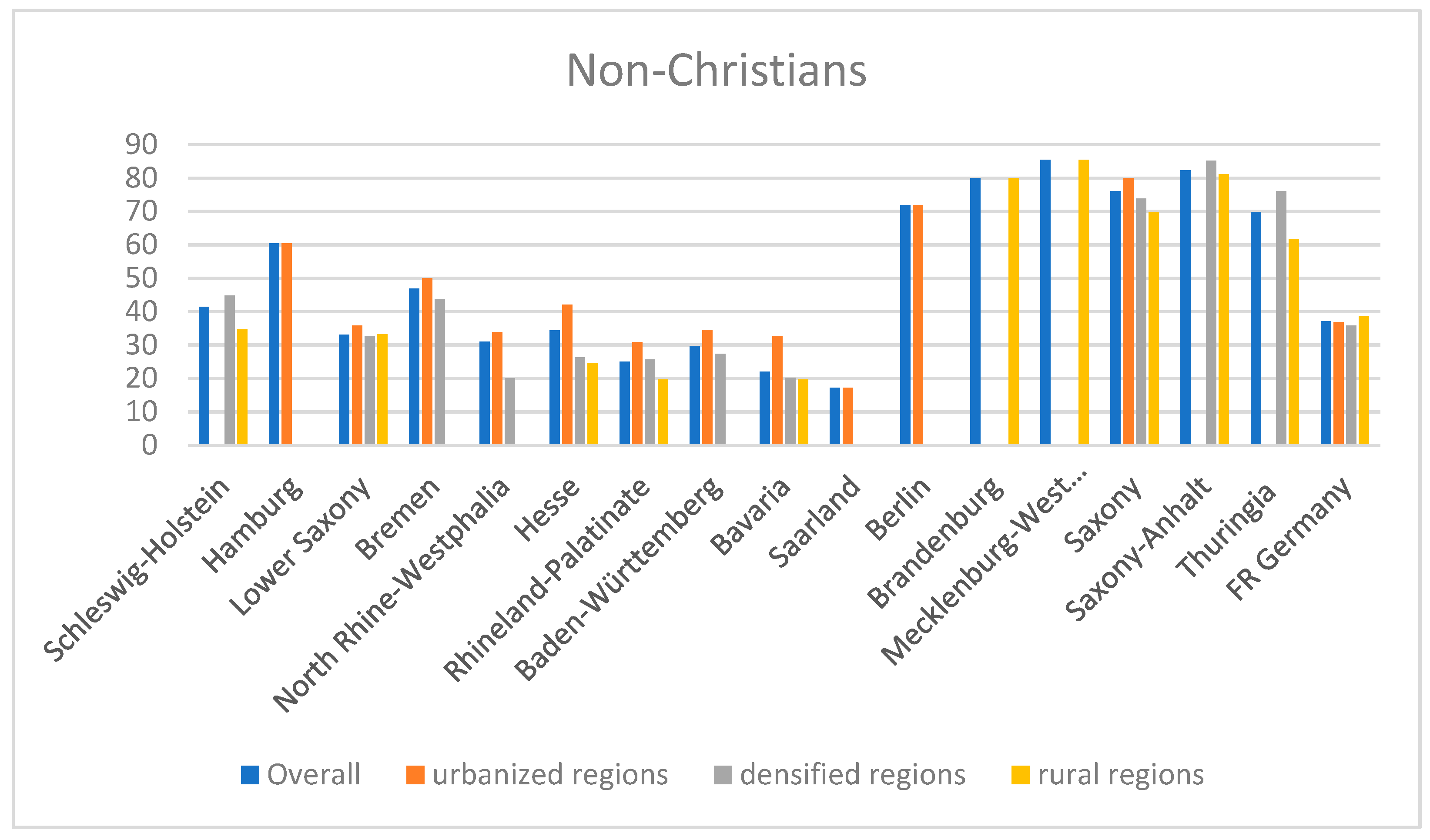



| Abbreviation | Variable Name | Calculation |
|---|---|---|
| UnempR | unemployment rate | unemployed/civilian labor force × 100 |
| ShareFEmp | share of female employees | female employees/all employees × 100 |
| EmpR | employment rate | employees at place of residence/inhabitant 15–< 65 years × 100 |
| FertR | fertility rate | ((newborn by women <20 J/women <20 years) + ... + (newborn by women >40 years/women 40–< 45 years)) × 5 |
| HouseInco | household income | disposable income per household/inhabitant |
| GDP | GDP per inhabitant | GDP/inhabitant/1.000 |
| ShareCath | share of Catholics | Catholics/inhabitant |
| ShareEvan | share of Protestants | Protestants/inhabitant |
| ShareNonden | share of nondenominational people | nondenominational people (or non-Catholics/Protestants)/inhabitant |
| N | Mean | St. Dev | Min | Max | |
| ShareCath | 70 | 4.54 | 8.11 | 1.66 | 69.44 |
| ShareEvan | 70 | 18.97 | 7.75 | 4.27 | 40.27 |
| ShareNonden | 70 | 76.5 | 10.73 | 19.62 | 94.07 |
| UnempR | 70 | 10.51 | 2.47 | 4.93 | 16.63 |
| ShareFEmp | 70 | 48.68 | 3.78 | 40.61 | 57.22 |
| GDP | 70 | 23.61 | 5.01 | 16.43 | 36.18 |
| EmpR | 70 | 57.22 | 3.24 | 49.89 | 64.62 |
| CDUCSU | 70 | 29.78 | 5.28 | 18.25 | 47.98 |
| DensityIn | 70 | 299.41 | 401.28 | 37 | 1.715 |
| FertR | 70 | 1.47 | 0.08 | 1.24 | 1.68 |
| HouseInco | 70 | 1421.76 | 63.84 | 1311 | 1643 |
| Descriptive | Statistics | West-Germany | (Excl. Berlin) | ||
| N | Mean | St. Dev | Min | Max | |
| ShareCath | 325 | 38.76 | 22.22 | 4.23 | 87.76 |
| ShareEvan | 325 | 32.79 | 17.22 | 4.06 | 72.34 |
| ShareNonden | 325 | 28.45 | 10.26 | 8.1 | 60.42 |
| UnempR | 325 | 5.63 | 2.56 | 1.43 | 16.29 |
| ShareFEmp | 325 | 45.3 | 4.28 | 28.82 | 57.35 |
| GDP | 325 | 33.38 | 14.42 | 13.99 | 124.01 |
| EmpR | 325 | 53.44 | 3.87 | 38.74 | 60.87 |
| CDUCSU | 325 | 36.52 | 7.1 | 20.31 | 54.82 |
| DensityIn | 325 | 555.58 | 682.36 | 40 | 4.393 |
| FertR | 325 | 1.4 | 0.1 | 1.06 | 1.66 |
| HouseInco | 325 | 1711.22 | 197.86 | 1275 | 3260 |
Publisher’s Note: MDPI stays neutral with regard to jurisdictional claims in published maps and institutional affiliations. |
© 2020 by the authors. Licensee MDPI, Basel, Switzerland. This article is an open access article distributed under the terms and conditions of the Creative Commons Attribution (CC BY) license (http://creativecommons.org/licenses/by/4.0/).
Share and Cite
Diller, C.; Gareis, P. Secularization, Religious Denominations, and Differences in Regional Characteristics: The State of Research and a Regional Statistical Investigation for Germany. Religions 2020, 11, 657. https://doi.org/10.3390/rel11120657
Diller C, Gareis P. Secularization, Religious Denominations, and Differences in Regional Characteristics: The State of Research and a Regional Statistical Investigation for Germany. Religions. 2020; 11(12):657. https://doi.org/10.3390/rel11120657
Chicago/Turabian StyleDiller, Christian, and Philipp Gareis. 2020. "Secularization, Religious Denominations, and Differences in Regional Characteristics: The State of Research and a Regional Statistical Investigation for Germany" Religions 11, no. 12: 657. https://doi.org/10.3390/rel11120657
APA StyleDiller, C., & Gareis, P. (2020). Secularization, Religious Denominations, and Differences in Regional Characteristics: The State of Research and a Regional Statistical Investigation for Germany. Religions, 11(12), 657. https://doi.org/10.3390/rel11120657






